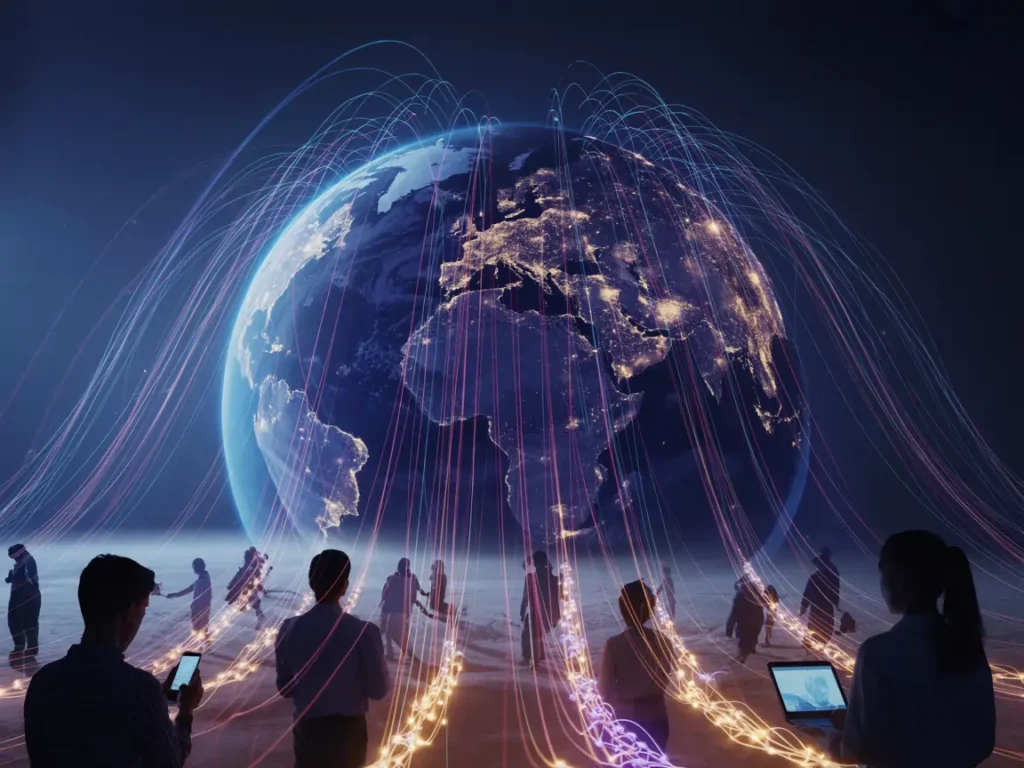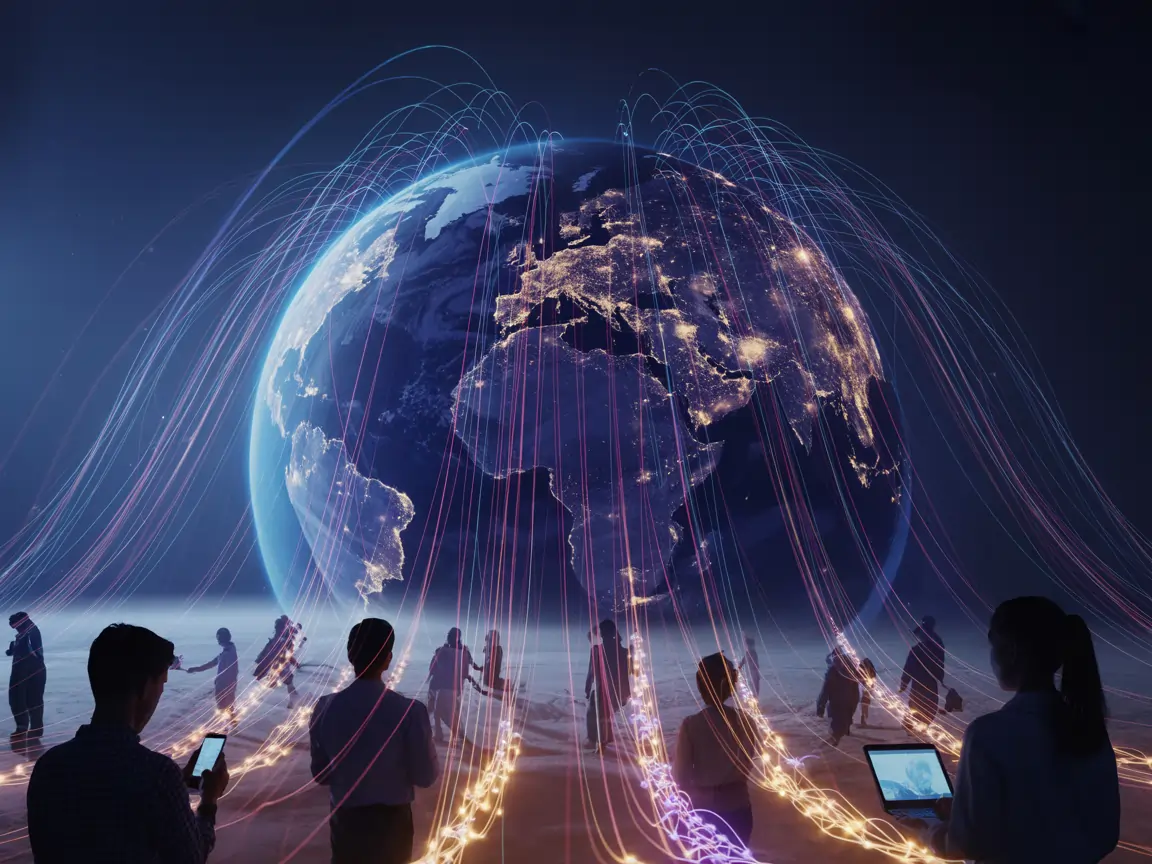David Allen Williams- Founder of PiXENDA

What if Everyone Could Mine AI Like Bitcoin?
Imagine a world where artificial intelligence isn’t just developed in centralized labs, but emerges from a global network of human contributors. Picture a farmer in rural Kenya earning income by contributing their smartphone’s processing power to train AI models. Envision a student in Bangladesh sharing anonymized data that helps develop better healthcare algorithms while earning tokens they can use for education. Think of communities worldwide collaborating to build AI solutions for local problems—all while sharing in the economic rewards.
This isn’t science fiction. We’re witnessing the birth of what visionary AI researcher Emad Mostaque calls the “intelligent internet”—and companies like DebitMyData are already building what they term the “Human Energy Grid.” This represents the next evolution of how we can expand AI development, creating global “AI mining” ecosystems that mirror Bitcoin’s revolutionary approach to decentralized networks while enhancing existing infrastructure.
The Convergence: From Vision to Reality
The timing is remarkable. As Emad Mostaque, former CEO of Stability AI, works on his master plan for an intelligent internet that puts humanity at the center of AI development, we’re seeing real companies like DebitMyData™ launch their billion-dollar “Human Energy Grid” that places people at the center of the digital economy through user-controlled AI agents and ethical monetization.
Both visions share a fundamental insight: the current AI landscape leaves enormous potential unrealized. While existing AI infrastructure has delivered incredible innovations, there’s an untapped opportunity to expand participation and multiply our collective intelligence by orders of magnitude.
The Opportunity: Expanding AI’s Reach and Impact
Today’s AI achievements are remarkable, but we’re only scratching the surface. The current paradigm, while successful, leaves significant gaps:
- Billions lack access to AI’s economic benefits
- Innovation potential remains unrealized in underserved regions
- Local problems persist that could benefit from AI solutions
- Diverse perspectives aren’t fully integrated into AI development
- Human agency is being diminished rather than enhanced
But what if we could amplify existing efforts by creating complementary networks that include everyone while strengthening current systems?
The Vision: Collaborative AI Mining for Everyone

Just as Bitcoin enabled anyone with a computer to participate in a global financial network, we can create decentralized AI ecosystems that work alongside existing infrastructure, where every person becomes a stakeholder in humanity’s digital intelligence.
How the Human Energy Grid Works
Universal Participation: Anyone with a device—from a smartphone in Mumbai to a laptop in Mexico City—can contribute:
- Compute Power: Lend processing capacity during idle hours to supplement existing data centers
- Data Contribution: Share anonymized information that improves AI models across all platforms
- AI Agent Training: Own and train personal AI agents (called “Agentic Avatars”) that can earn through sponsorships, licensing, and personal branding
- Digital Identity: Control and monetize your digital footprint through blockchain-protected Digital Identity LLMs (DID-LLM)
Economic Rewards: Contributors earn AI-native tokens for their participation, creating new income streams that complement traditional employment while building network effects.
Inclusive Governance: Decentralized systems ensure that diverse voices shape AI’s future, working alongside established institutions to guide development toward human benefit.
The Technology Making It Possible
This vision builds on existing AI infrastructure while creating new pathways for participation. We’re seeing multiple approaches converge:
Emad Mostaque’s Intelligent Internet Framework
Mostaque’s approach centers on what he calls “proof of benefit”—instead of Bitcoin’s energy-intensive proof of work, mining rewards go to providing free AI for education, healthcare, and other social goods. His framework includes:
- Universal Basic AI: Free, high-quality AI models that run on modest hardware (like his 8-billion parameter medical AI that runs on a Raspberry Pi)
- National AI Champions: Locally-owned compute networks that serve their communities while participating in the global system
- Sectoral Specialization: Dedicated AI models for healthcare, education, and governance that prioritize transparency and local control
- Foundation Coins: A Bitcoin-like currency where 100% of mining proceeds fund supercomputers for cancer research, autism, and other humanitarian challenges
DebitMyData’s Human Energy Grid

DebitMyData™ is implementing a complementary approach with their Human Energy Grid, which recently closed an oversubscribed seed round to fund global expansion. Their system provides:
- Agentic Avatars: AI agents that users own and train, earning income through digital sponsorships and licensing
- Cryptographic Identity Verification: Blockchain-protected digital identities that prevent deepfakes and fraud
- Ethical AI Training: Decentralized avatar networks that contribute to safe, human-aligned AI development
- NFT-Backed Security: Transparent royalties and rights protection for digital creations
Leading Blockchain Networks
Bittensor (TAO): Creates a peer-to-peer machine learning network where nodes earn tokens for contributing compute power and intelligence, supplementing traditional training methods with distributed intelligence.
Render (RNDR): Enables individuals to contribute GPU power for AI and rendering tasks, creating a hybrid model that enhances existing rendering capabilities while earning tokens.
Fetch.ai (FET): Powers autonomous AI agents with token economics, enabling AI solutions to operate across different platforms and ecosystems.
Real-World Impact: Expanding AI’s Benefits
Economic Inclusion Through Human Energy
- A teacher in Brazil contributes educational data, improving global learning algorithms while earning tokens that supplement their income
- A teenager in India creates and trains an Agentic Avatar that earns sponsorship revenue during idle hours
- Small businesses worldwide access AI tools through token-based systems that make advanced technology affordable
Enhanced Problem-Solving Through Collaboration
- Farmers use AI for crop optimization powered by networks that include their own contributions and local agricultural knowledge
- Communities develop healthcare diagnostics using locally-relevant data combined with globally-trained models
- Climate change solutions emerge from broader collaboration between distributed networks, research institutions, and existing infrastructure
Democratic Innovation Through Ownership
- Underrepresented communities gain voice in AI development through DAO governance and economic participation
- Local problems get addressed because contributors have direct economic incentives to solve them
- Transparency and fairness are enhanced through blockchain verification and community oversight
From 8 Billion to 800 Billion: The Scale Opportunity
Here’s where the numbers become staggering. As Mostaque points out, we currently have about 20 million GPUs globally serving 8 billion people—that’s 400 people sharing each GPU. But his research shows that specialized AI models (like his 8-billion parameter doctor that outperforms GPT-4 on medical benchmarks) can run efficiently on modest hardware.
The breakthrough insight: Instead of building massive general-purpose models that consume enormous compute, we can create billions of specialized, efficient AI agents that serve specific human needs while requiring far less energy.
This isn’t just about efficiency—it’s about accessibility. When AI can run on devices people already own, participation becomes universal rather than limited to those with access to powerful hardware.
The Economics of Human Energy

Mostaque’s economic analysis reveals a fundamental shift coming to how money works in an AI-driven world. As he explains: “Labor isn’t the key driver of productivity anymore. We need to have a new equation for that.”
The Current Problem: Traditional economics assumes money flows from labor to capital through work and bank deposits. But when AI agents can outcompete humans at most knowledge work, this system breaks down.
The Solution: Create money flows that reward human participation in the AI ecosystem itself. In Mostaque’s model, people mint “culture coins” by contributing to and using AI systems beneficially. DebitMyData’s approach enables users to earn from their data and digital identity, marking a shift from extractive models toward equitable participation.
Why This Collaborative Approach Matters Now

We’re at a critical juncture where the decisions made today about AI’s structure will determine whether technology amplifies human potential or diminishes it. Current trajectories risk creating what Mostaque calls “the great decoupling”—where AI systems become so advanced that humans can’t compete economically.
The collaborative path offers a different future:
- Economic Integration: AI enhances human capabilities rather than replacing them
- Distributed Benefits: Value flows to everyone who contributes, not just infrastructure owners
- Cultural Preservation: Local communities maintain agency over their AI systems and data
- Innovation Acceleration: Diverse global participation drives solutions to previously unsolved problems
The Path Forward: Building Bridges
Technical Integration
- Interoperability: Developing protocols that allow decentralized networks to work with existing AI systems
- Efficiency Optimization: Creating algorithms that make distributed contributions meaningful and valuable
- User Experience: Building interfaces that make participation as simple as using any app
Collaborative Frameworks
- Partnership Models: Creating structures where established organizations benefit from distributed networks
- Skill Development: Educational programs that prepare people to contribute meaningfully to AI development
- Trust Networks: Transparent systems that build confidence across all participants
Sustainable Growth
- Energy Coordination: Aligning distributed computing with renewable energy sources and efficient existing infrastructure
- Global Access: Working with telecommunications and hardware providers to expand participation
- Economic Stability: Developing mechanisms that provide reliable value for all contributors
Join the Human Energy Revolution
The future of AI doesn’t need to be written by a few—it can be authored by all of us, working together with existing leaders and emerging contributors. Here’s how you can participate:
- Learn: Explore projects like Bittensor, Render, and DebitMyData to understand how distributed AI enhances existing systems
- Contribute: Start by joining networks that reward compute, data sharing, or AI agent development
- Connect: Share this vision and discuss how inclusive AI development can enhance your community
- Build: If you’re technical, contribute to open-source AI projects that bridge different approaches
- Collaborate: Support initiatives that bring together diverse participants in AI development
The Bottom Line: A New Foundation for Intelligence

Bitcoin showed us that financial networks could expand beyond traditional banks while working alongside them. Projects like Bittensor, DebitMyData, and Mostaque’s intelligent internet are proving that artificial intelligence can expand beyond centralized development while enhancing existing capabilities.
The question isn’t whether we should replace current AI systems—it’s whether we’ll choose to build the infrastructure that makes AI development more inclusive, more beneficial, and more aligned with human flourishing.
As DebitMyData’s founder Preska Thomas puts it: “This is our moment—not just to advance AI but to protect what makes us human. The Human Energy Grid ensures humanity stays present, empowered, and valued in the algorithms that shape the future.”
The infrastructure exists. The economics are aligning. Real companies are building real solutions. All that’s needed is the collective will to choose expansion—one where AI mining isn’t limited to data centers, but includes every human being who wants to contribute while working alongside established institutions.
The future of AI is too promising to limit to current approaches. It’s time to make it bigger, more inclusive, and more human-centered.
What role will you play in building the Human Energy Grid? The network is ready for your contribution, working alongside everything that’s already being built.
Resource Links
1. Explore the Intelligent Internet Framework
The Intelligent Internet Foundation – ii.inc
Dive deeper into Emad Mostaque’s comprehensive master plan for building a human-centered AI infrastructure. Access the full white papers, technical specifications, and roadmap for creating “proof of benefit” mining systems where AI development directly serves humanitarian goals. Sign up to receive updates on the Foundation Coin launch and learn how to participate in building universal basic AI for education, healthcare, and community benefit.
2. Join the Human Energy Grid
DebitMyData – Human Energy Grid Platform
Start participating in the real-world implementation of human-centered AI economics. Create your own Agentic Avatar, learn about Digital Identity LLMs (DID-LLM), and explore how to monetize your digital contributions through sponsorships and licensing. DebitMyData’s platform demonstrates how individuals can reclaim control of their digital footprints while earning from their participation in AI development. Explore their Agentic Avatar Foundation and see how the Human Energy Grid is being deployed globally.
Additional Learning Path:
For readers interested in the broader ecosystem of decentralized AI projects mentioned in this post, explore Bittensor (bittensor.com), Render Network (render.com), and Fetch.ai to understand how different approaches to collaborative AI development are converging toward the same human-empowering vision.
These links provide both the theoretical framework (Emad’s vision) and practical implementation (DebitMyData’s platform), giving readers immediate ways to engage with these concepts rather than just reading about them.

